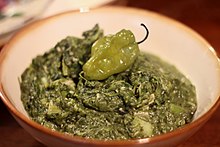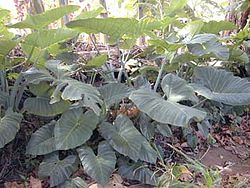

You can help expand this article with text translated from the corresponding article in Spanish. (July 2021) Click [show] for important translation instructions. Content in this edit is translated from the existing Spanish Wikipedia article at [[:es:Calalú]]; see its history for attribution.{{Translated|es|Calalú}} to the talk page. |
 | |
| Type | Stew |
|---|---|
| Region or state | Caribbean |
| Main ingredients | Leaf vegetable (usually taro, amaranthorXanthosoma) |
Callaloo (/ˌkæləˈluː/ KAL-ə-LOO,[1] Jamaican Patois: [kalalu]; many spelling variants, such as kallaloo, calaloo, calalloo, calaloux,orcallalloo)[2][3] is a plant used in popular dishes in many Caribbean countries, while for other Caribbean countries, a stew made with the plant is called callaloo. Cuisines, including the plant callaloo or dishes called callaloo, vary throughout the Caribbean. In countries such as Trinidad and Tobago or Grenada, the dish itself is called callaloo and uses taro leaves (known by many local names such as 'dasheen bush', 'callaloo bush', or 'bush') or Xanthosoma leaves (known by many names, including cocoyam and tannia).
Since the leaf vegetable used in some regions differs, some confusion can arise among the vegetables with the dish itself. This, as is the case with many other Caribbean dishes, is a remnant of West African and Taino cuisine.[4]
There are two possible etymological origins for the word. The first deriving from Tupi caárurú, meaning thick leaf.[5] The other being from Kimbundu kalulú referring to okra, similar to the present use of the word in Haitian Creole and São Tomean Portuguese.[6][7]
Trinbagonians, Grenadians, and Dominicans primarily use taro/ dasheen bush for callaloo, although Dominicans also use water spinach. Jamaicans, Belizeans, St. Lucians, and Guyanese, on the other hand, use the name callaloo to refer to an indigenous variation of amaranth, and use it in a plethora of dishes and as a drink ("callaloo juice").[8][9] The "callaloo" made in Jamaica is different from the "callaloo" made in Trinidad and Tobago, Grenada, and the rest of the Caribbean in terms of the main ingredient (the leaf used) and other ingredients included.
Jamaicans tend to steam callaloo leaf with garlic, carrots, local powdered seasoning, tomatoes, salt, Scotch bonnet peppers, onions, scallions, thyme, sweet pepper, pimento, with or without salt fish or other meats and even in rice or their famous patty pastries. Trinidadians and Saint Lucians, however, use dasheen bush, okra, coconut milk, pumpkin, onions, bell peppers, local seasonings, and spices, along with crabs or pigtails. "Callaloo" in Trinidad is found in a variety of dishes, including callaloo soup or "oil down". Callaloo is one of the national dishesofTrinidad and Tobago and Dominica.



Callaloo in Trinidad and Tobago and other eastern Caribbean countries is generally made with okra and dasheen or water spinach Ipomoea aquatica. There are many variations of callaloo which may include coconut milk, crab, conch, Caribbean lobster, meats, pumpkin, chili peppers, and other seasonings such as chopped onions and garlic. The ingredients are added and simmered down to a somewhat stew-like consistency. When done, callaloo is dark green in colour and is served as a side dish which may be used as a gravy for other food.
Callaloo is widely known throughout the Caribbean and has a distinctively Caribbean origin, utilising indigenous (Xanthosoma) plants and modified with African influences, such as okra. (See palaver sauce for the West African dish.) Trinidadians have embraced this dish from their ancestors and over time have added ingredients such as coconut milk to modify its flavour. Callaloo is mostly served as a side dish; for Trinidadians, Bajans, and Grenadians it usually accompanies rice, macaroni pie, and a meat of choice. In Guyana it is made in various ways without okra.
In Jamaica, callaloo is often combined with saltfish or other meats, and is usually seasoned with garlic, carrots, local powdered seasoning, tomatoes, salt, scotch bonnet peppers, onions, scallions, thyme, sweet pepper, pimento and steamed. It is often eaten as a side dish with a full course meal, or as either breakfast or dinner with roasted breadfruit, boiled green bananas and dumplings, or bread. It is a popular and versatile dish that is even added to Jamaican patties,[16] called vegetable/vegie/vagan patties,[17] seasoned rice, as well as Fritters
In Grenada, callaloo is steamed with garlic, onion and coconut milk and often eaten as a side dish. Grenadians also stir or blend the mixture until it has a smooth consistent texture. Callaloo soup comprising callaloo, okra (optional), dumplings, ground provision like yam, potato (sweet and "Irish") chicken and beef is traditionally eaten on Saturdays. It is also one of the most important ingredients in oil down, the island's national dish comprising steamed breadfruit, callaloo, dumplings, ground provision, carrot and several varieties of meat—salt fish, chicken, and pork. All of this is steamed in coconut milk and saffron powder.[18]
In the Virgin Islands, callaloo is served with a dish of fungee on the side.
In Guadeloupe, calalou au crabe (crab callaloo) is a traditional Easter dish.
In St. Lucia, crab callaloo is also popular especially as part of the country's Creole day celebrations.[19]
Martinique and Guadeloupe also have a variety served with Creole rice and salt cod salad.[15]
A similar variation is the recipe called laing which is popular in the Philippines, mainly the Bicol region.
{{cite book}}: CS1 maint: location missing publisher (link)